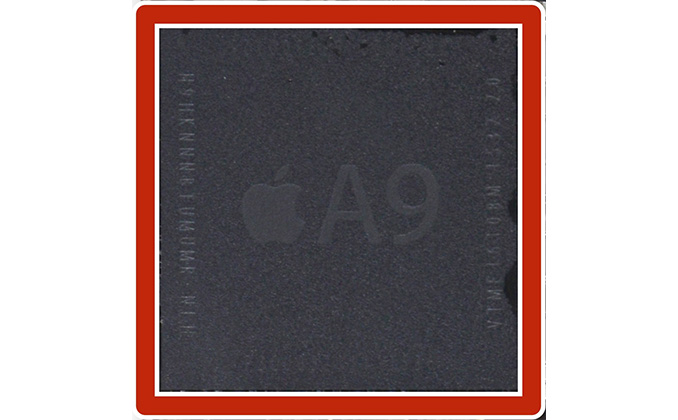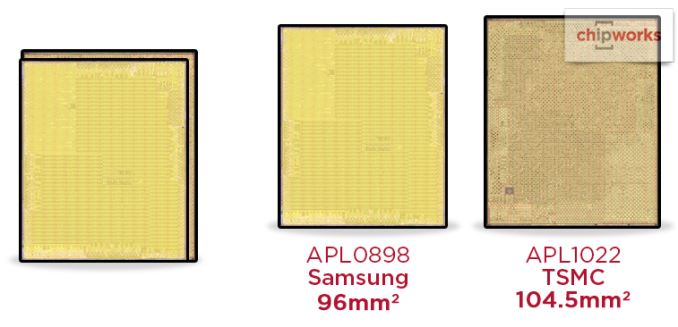Apple’s A9 SoC Is Dual Sourced From Samsung & TSMC
by Ryan Smith on September 28, 2015 7:00 PM EST
Picking up from our conversation this morning on Apple’s A9 SoC, the crew over at Chipworks has been working hard over the weekend to decap A9 and their first results are in. As it turns out, Chipworks has found chips fabbed by both TSMC and Samsung, which means that A9 is in fact a dual sourced part.
In taking apart iPhones and decapping SoCs, Chipworks has turned up two SoCs. The first, APL0898, is a 96mm2 A9 that’s fabbed by Samsung. The second SoC, APL1022, is a 104.5mm2 SoC fabbed by TSMC. And while Chipworks isn’t naming the specific manufacturing processes used, based on Apple’s comments on a “new transistor architecture,” we’re certainly looking at a form of FinFET. In which case the two chips are made on versions of Samsung’s 14nm FinFET and TSMC’s 16nm FinFET processes respectively.
This development is interesting for a few different reasons. From a fabrication standpoint, Samsung and TSMC have been brawling at multiple levels (technical and legal) to be the first to get a next-generation FinFET process out the door, with Samsung ultimately winning that battle when they shipped the 14nm Exynos 7420 for the Galaxy S6 family. For TSMC on the other hand this is as far as we know the first consumer product released with a 16nm TSMC fabbed part, indicating that TSMC is finally able to ship such parts in a reasonable volume.
More importantly, this is a huge move for Apple, and one we admittedly don’t have all of the facts about at this time. Dual sourcing parts is by no means a new concept – IBM requiring a second source of x86 chips is how AMD got started in the x86 industry, after all – but in more modern times dual sourcing of high performance parts is very rare due to how difficult and expensive it is. With dual sourcing essentially requiring the chip to be taped out twice – once for each fab – it requires significant financial and engineering resources, a cost that not very many companies besides Apple can take on without significant risk.
| Apple A9 SoC Versions | ||||
| APL0898 | APL1022 | |||
| Manufacturing Process | Samsung 14nm FinFET | TSMC 16nm FinFET | ||
| Die Size | 96mm2 | 104.5mm2 | ||
The big hurdle with dual sourcing a part such as a cutting-edge SoC like A9 is that unless the source fabs have designed their processes to be near identical – to form a common foundry specification – then different fabs will have different processes with different characteristics. This in turn is determined by the technical decisions a fab made in research and development, and the specific issues the fab ran into when bringing up the new process. The end result being that while two fabs can turn out chips based around the same design, those chips will not be identical. It’s this kind of inconsistency that chip customers like Apple have to tackle head-on if they want to go with dual sourcing.
Even at a physical level we can see this inconsistency right away in terms of die sizes. Despite the TSMC and Samsung processes being quite similar, the Samsung A9 is the smaller of the two by 8%, which as Chipworks notes is indicative of better density on Samsung’s 14nm node. What we don’t see, and the issue Apple really has to control for, is power consumption. Right now it’s a safe assumption that both chips can reach Apple’s required clockspeeds, so in order for Apple to utilize both in the iPhone 6s they need to make sure both perform as identically as possible, especially when it comes to idle power leakage and power consumption at different clockspeeds. The billion dollar question right now is whether either of the A9s is consistently better than the other one, and in which case by how much. For Apple it’s best that these chips are identical as possible – and they can make design choices when taping out the chip for each fab to help ensure this – but at the end of the day even Apple has to bow down to the laws of physics.
But the biggest unknown right now is why Apple would do this given the difficulties involved; to develop two A9s at twice the price. We can certainly speculate on reasons they would do this – yield issues at a fab, a desire to avoid putting all of their eggs in one basket and giving one fab too much power, or even just wanting to ramp up A9 production quickly by doubling the number of fabs working on it. But at the end of the day I don’t expect that’s a secret that will be known beyond the halls of One Infinite Loop, so speculation is all we have to work with for now.
In any case, if Apple has done their homework then dual sourcing A9s shouldn’t have an impact on average consumers, beyond perhaps ensuring that Apple has a sufficient supply to meet demand (ed: Apple sold 13mil iPhones in their opening weekend). Otherwise for techies, things are both more interesting and frustrating; just dual sourcing A9 makes an interesting product since this is something we almost never see done these days. As for the billion dollar question of which A9 is better, that will be a tossup. With enough time, effort, and a very large number of iPhones, it should be possible to coarsely determine if the A9s significantly differ in battery life, and thereby power consumption. However given the difficulties in taking an iPhone apart to access the A9, one would really need a software identification method to really make use of this information.
Source: Chipworks (A9 Shot Courtesy iFixit)












99 Comments
View All Comments
mortimerr - Tuesday, September 29, 2015 - link
Thanks for the post.Everyone was talking about how the sky was falling because Intel delayed a Tick, when I guess it seems like their clock, so to speak, is just a little behind everyone else's.
Maybe, possibly...hopefully, now that Intel isn't at the top of the pack anymore will cause them to improve?
Morawka - Tuesday, September 29, 2015 - link
TSMC will never be that fast. Their shrinks always take 2 years or more. TSMC doesnt have very smart engineers imo, all they can do is make small chips.. when they try and make anything over 110mm the yields get destroyed. Samsung is the future fab imoastroboy888 - Saturday, October 3, 2015 - link
You must be confusing TSMC with someone else or just have no idea of the semiconductor industry. TSMC holds over 70% of the world market share on contracted semiconductors. For example, the inventor of the "FinFet" or 3D gate worked for TSMC and they were the pioneers of that technology.Break open every electronic device that you have ever owned in your life time, you will find that at least 70% of the chips are made by TSMC. (Even your Samsung phone!!!) TSMC products are all around you, you were born with it you grew up with you, but you just have no idea!
name99 - Tuesday, September 29, 2015 - link
Exactly. This is no conceptually different from Apple using RAM from both Hynix and Micron, or using flash from both Samsung and Toshiba. Of course the product is question is bespoke --- designed by Apple and manufactured to their specs, not for sale on the open market. But once you get past that detail, everything else is the same.I think this shows the power of trying to do one thing well, rather than a dozen things sorta well.
Yes Apple had to design two mask sets and run through two sets of physical optimization for this. But Intel creates god knows how many mask sets to handle every damn version of Broadwell or Skylake, from crappy Pentium and Celeron versions to the K versions. Sure, some of that is handled by just fusing off features, but at least some of it seems to really require masks that are putting fewer CPU and/or GPU cores and/or L3 SRAM on the die.
At the end of the day, Apple's ability to have every engineer in the team optimizing ONE design (and TWO implementations) rather than splitting them across a dozen different designs seems to be paying off as much as the same philosophy when applied at the product level. Two designs here only seems like a lot of work when you ignore how much more (probably pointless) work Intel and QC and so on engage in.
Link - Tuesday, September 29, 2015 - link
It seems Apple used Samsung on 6s and TSMC on 6s+ according iFixit.6s+
https://d3nevzfk7ii3be.cloudfront.net/igi/kFywxSJ4...
6s
https://d3nevzfk7ii3be.cloudfront.net/igi/Yfme6TtQ...
Wolfpup - Tuesday, September 29, 2015 - link
As per this article, that 's incorrect. That's just luck of the draw. You can get either in either. It doesn't matter.tipoo - Tuesday, September 29, 2015 - link
Chipworks found two different chips in two of the same 6S modelingwe - Monday, September 28, 2015 - link
Well I didn't expect that. Very interesting...baconforall - Monday, September 28, 2015 - link
For such an important product for Apple, yeah it does indeed make a lot of sense to tape out from two foundries even with the added cost of doing so -- especially for risk mitigration because of the sales volume of iPhones. Any delay or yield issue with only one fab isn't be such a deal breaker anymore. Just look at AMD and GloFlo...Also, with other fabless companies scrambling to utilize these lower nodes now that they are finally yielding a bit more, maybe they are somewhat forced to spread the love out.
But sorry to the guys taping out the same thing twice on different processes. I can't even imagine the design rule checks at 14nm...
SunnyNW - Monday, September 28, 2015 - link
I believe I remember reading on Anandtech, either in the 7420 deep-dive or galaxy s6 review, that Samsung binned their 7420 socs based on power characteristics with a rating system and a consumer device would be guaranteed to only ship with an soc below a certain number(or above cant remember). Therefore certain 7420 socs had lower power consumption on the power curve and I believe according to that article that this information could be obtained through the software...So...I was just wondering does Apple do this, is there a way to get this info from iphones? I apologize if I'm worng here.....